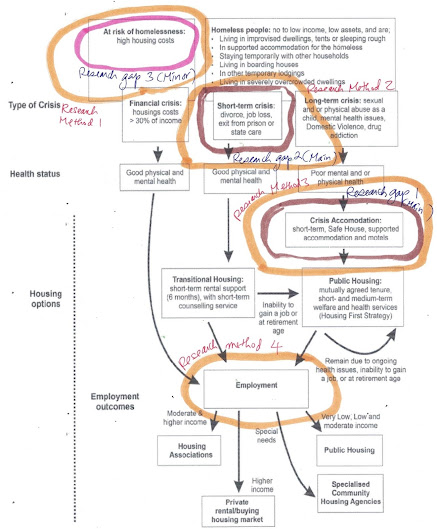Drawing on my study note on the research gap-translation exercise to firm up on a research gap idea, I present an example on each of the four agile literature review approach (ALRA) deliverables for an academic-oriented dissertation project [for Housing Studies] as follows:
Deliverable 1: a research gap-translation diagram:
A research gap-translation diagram indicates the endeavor to firm up on the overall research gap (Domain C) about "inadequate usable theories and supportive empirical findings for informing the analysis of the intellectual curiosity of the researcher in Domain A" (Domain A being the triggering point of intellectual curiosity of the researcher).
Research gaps | Corresponding research objectives |
Research gap item 1 (main): inadequate existing empirical studies as well as usable theories to find out and analyze the crisis accommodation of the homeless generation X in Shamshuipo | Research objective 1 (main): to conduct empirical research and develop more usable theories on the crisis accommodation of the homeless generation X in Shamshuipo. |
Research gap item 2 (main): inadequate existing empirical studies as well as usable theories to find out and analyze the short-term crisis of the homeless generation X in Shamshuipo | Research objective 2 (main): to conduct empirical research and develop more usable theories on the short-term crisis of the homeless generation X in Shamshuipo |
Research gap item 3 (minor): inadequate existing empirical studies as well as usable theories to find out and analyze the homelessness risk of the homeless generation X in Shamshuipo | Research objective 3 (minor):
|
Note: the core-focus-domain comprises the two main research objectives of 1 and 2.
Deliverable 3: theoretical framework-A
Note: the illustrative example of theoretical framework makes use of the diagram obtained via Google search (source). In actual practice, a customized theoretical framework should be the output of the idea synthesis effort from the research project student.
Deliverable 4: theoretical framework-B
Research method 1: Interview research
Research method 2: Observational research
Research method 3: Desk research
Research method 4: Questionnaire survey
A related reading: on the theory measurement unit of the theory-based research gap-translation process.



No comments:
Post a Comment